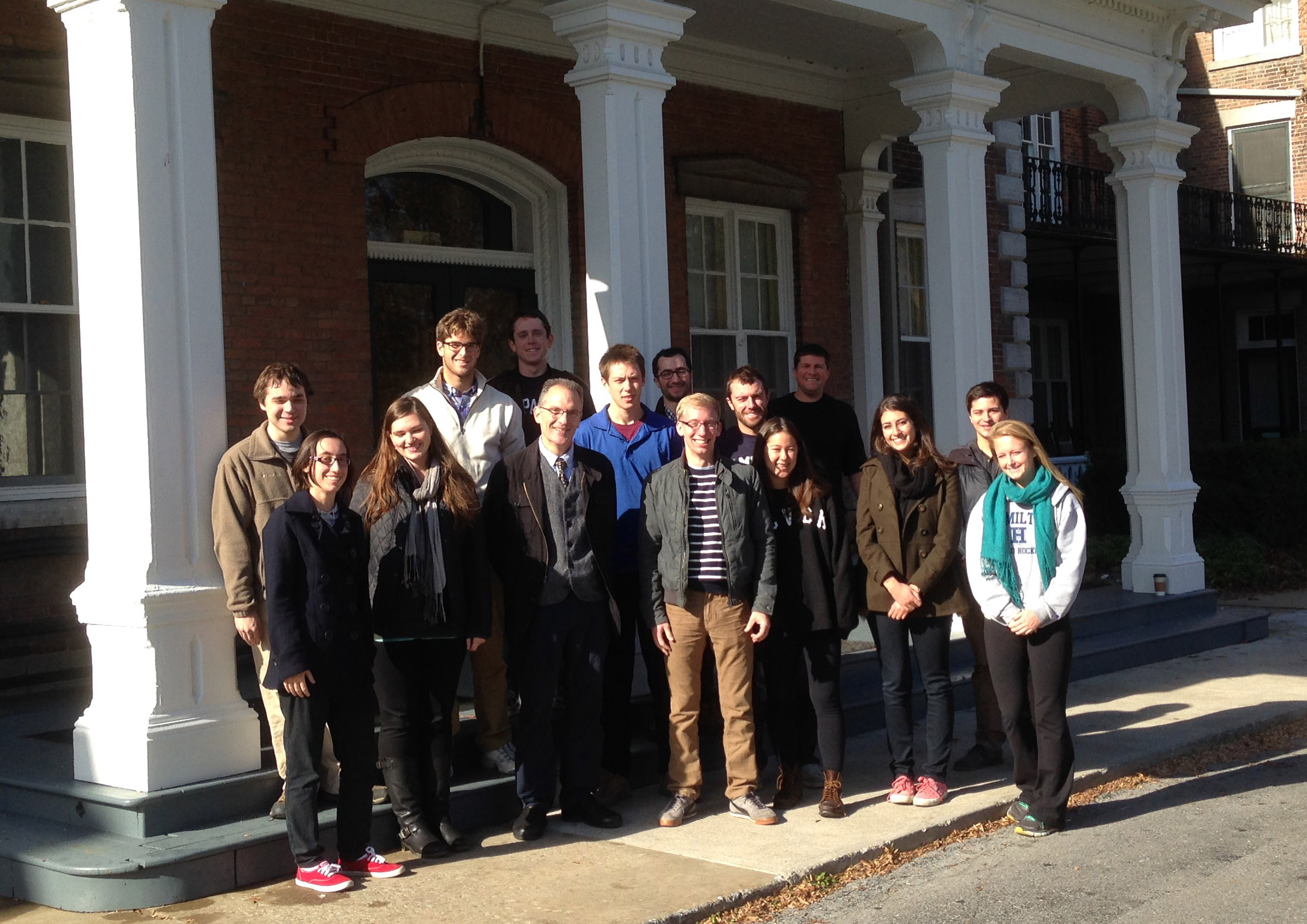
For many people, the words “history class” conjure up images of dusty books, and it’s true that American Communal Religious Societies, co-taught by Professor of History Doug Ambrose and Director of Special Collections Christian Goodwillie, does have most of its weekly class meetings in Burke Library. Most, but not all.
On November 4, the class left the library behind for the Mansion House, an opulent Italian villa located in an unlikely place: the nearby city of Oneida, New York. The villa was home to the members of the Oneida Community, a utopian religious society led by John Humphrey Noyes that operated from 1848 to 1880. Students received an in-depth overview of the site from curator Tony Wonderly, and were then given tours of the property itself.
Ambrose explained the purpose of the new class. “The course seeks to expose students to two wonderful Hamilton College resources: our stellar Communal Societies Collection in Burke Library's Special Collections and Christian Goodwillie, the gifted director of Special Collections and Archives, with whom I teach the class.
“We provide the students with a broad exposure to many of the various religious communal societies that have been established in the United States between the 17th and 20th centuries, including the Shakers, the Oneida Community, the Amana Inspirationists, and the House of David/Mary's City of David,” said Ambrose. “We acquaint them with the some of the rare books, documents, artifacts and ephemera that comprise the Communal Societies Collection.”
Members of the Oneida Community lived together in the house, and practiced a form of communal ownership derived from Biblical precedents. They held everything in common, including their possessions, their business ventures and, most notoriously, their spouses. Oneida community members were required to participate in Noyes’ system of “complex marriage,” where every member of the community was married to every other member, creating a large, integrated family. It was an arrangement that made both practical and spiritual sense to the community’s members, and this unity helped sustain Noyes and his disciples for four decades.
“We like to say that Oneida was the most radical and the most radically successful utopian group of the nineteenth century,” Mansion House curator Wonderly said. Comparable utopian experiments, he noted, typically lasted only a fraction of the time—10 or 20 years.
The religious revivals that swept the United States in the 1830s, as well as by the ideas of French utopian thinker Charles Fourier deeply influenced Noyes when he founded the community. Unlike other Fourierist communities that were founded in the U.S. and in Britain, though, Noyes fused Fourier’s theories with the religious concept of Perfectionism, which stated that people could achieve salvation simply by choosing not to sin—a seemingly simple idea that was nonetheless fairly radical for the time.
Although the name “Oneida” is today most closely associated with silverware (which the community started manufacturing in the early 1900s), the mansion house was built with the proceeds from Newhouse-brand steel animal traps, the Oneida Community’s first successful manufactured product. Newhouse traps were better designed and stronger than competitors, and they very quickly dominated the market, bringing the community thousands of dollars in revenue.
As students learned, a good chunk of that money was reinvested in the Mansion House. The members of the Oneida community believed that “human happiness is pleasing to God,” Wonderly said. “Community members did not live in the Middle Ages,” he said.
Instead, the community installed expensive amenities like steam heating and cultivated vast gardens, creating an atmosphere of enjoyment and luxury, unlike the Shaker’s Spartan approach to utopian living.
The community’s financial successes, however, were not enough to protect it from popular outrage over the community’s complex marriage system, which also advocated “free love”—a term Noyes may have coined himself. Somewhat unexpectedly, according to Goodwillie, the man leading the charge against the community was none other than Hamilton professor John Mears.
“Mears was the Community’s greatest enemy during the 1870s,” Goodwillie said. “He was completely outraged by the group’s unique sexual and reproductive practices, so it’s more than a little ironic that Hamilton students are visiting the Mansion House 130 years later!”
This is the second field trip the class has taken—earlier in the semester, they visited several Shaker sites in eastern New York and western Massachusetts, including Hancock Shaker Village, where Goodwillie was formerly curator.
“One of the best parts about taking this class is that a lot of the groups we discuss started right in our backyard,” Ben Swett ’14 said. “It’s great to be able to understand the community better by visiting it in person.”
Ambrose concluded that through this class, he and Goodwillie “want students to deepen their understanding of the significance of communal societies to the religious, cultural, social and economic history of the United States. We also hope they develop an appreciation for Hamilton’s crucial role in collecting, preserving and promoting the use of the invaluable material housed in Burke's Special Collections,” he explained.
